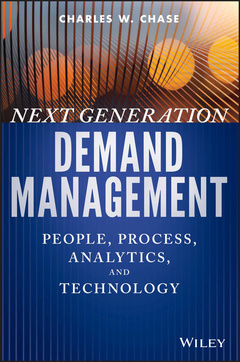Next Generation Demand Management People, Process, Analytics, and Technology Wiley and SAS Business Series
Auteur : Chase Charles W.

Next Generation Demand Management is a guidebook to next generation Demand Management, with an implementation framework that improves revenue forecasts and enhances profitability. This proven approach is structured around the four key catalysts of an efficient planning strategy: people, processes, analytics, and technology. The discussion covers the changes in behavior, skills, and integrated processes that are required for proper implementation, as well as the descriptive and predictive analytics tools and skills that make the process sustainable. Corporate culture changes require a shift in leadership focus, and this guide describes the necessary "champion" with the authority to drive adoption and stress accountability while focusing on customer excellence. Real world examples with actual data illustrate important concepts alongside case studies highlighting best-in-class as well as startup approaches.
Reliable forecasts are the primary product of demand planning, a multi-step operational supply chain management process that is increasingly seen as a survival tactic in the changing marketplace. This book provides a practical framework for efficient implementation, and complete guidance toward the supplementary changes required to reap the full benefit.
- Learn the key principles of demand driven planning
- Implement new behaviors, skills, and processes
- Adopt scalable technology and analytics capabilities
- Align inventory with demand, and increase channel profitability
Whether your company is a large multinational or an early startup, your revenue predictions are only as strong as your supply chain management system. Implementing a proven, more structured process can be the catalyst your company needs to overcome that one lingering obstacle between forecast and goal. Next Generation Demand Management gives you the framework for building the foundation of your growth.
Foreword xiii
Preface xv
Acknowledgments xxi
About the Author xxiii
Chapter 1 The Current State 1
Why Demand Management Matters More Than Ever 4
Current Challenges and Opportunities 14
Primary Obstacles to Achieving Demand Management Planning Goals 21
Why Do Companies Continue to Dismiss the Value of Demand Management? 23
Summary 28
Key Learnings 29
Notes 30
Further Reading 30
Chapter 2 The Journey 31
Starting the Supply Chain Journey 32
Introducing Sales & Operations Planning (S&OP) into the Supply Chain Journey 34
Sales & Operations Planning Connection 34
Transitioning to a Demand-Driven Supply Chain 40
The Digitalization of the Supply Chain 46
Leveraging New Scalable Technology 51
Benefits 52
Summary 53
Key Learnings 54
Notes 57
Chapter 3 The Data 59
What Is Big Data? 60
Why Is Downstream Data Important? 68
Demand Management Data Challenges 71
CPG Company Case Study 75
Does Demand History Really Need to Be Cleansed? 78
How Much Data Should Be Used? 81
Demand-Signal Repositories 82
What Is Demand Signal Analytics? 86
Demand Signal Analytics Key Benefits 87
Summary 89
Key Learnings 91
Notes 92
Further Reading 93
Chapter 4 The Process 95
Centers of Forecasting Excellence 97
Demand Management Champion 99
Demand-Driven Planning 100
What Is Demand Sensing and Shaping? 100
A New Paradigm Shift 113
Large-Scale Automatic Hierarchical Forecasting 115
Transactional Data 116
Time Series Data 117
Forecasting Models 117
Skill Requirements 120
Summary 121
Key Learnings 123
Further Reading 125
Chapter 5 Performance Metrics 127
Why MAPE Is Not Always the Best Metric 128
Why In-Sample/Out-of-Sample Measurement Is So Important 131
Forecastability 135
Forecast Value Added 137
Ho: Your Forecasting Process Has No Effect 138
Summary 144
Key Learnings 145
Notes 146
Further Reading 146
Chapter 6 The Analytics 147
Underlying Fundaments of Statistical Models 148
How Predictable Is the Future? 153
Importance of Segmentation of Your Products 157
Consumption-Based Modeling 167
Consumption-Based Modeling Using Multi-Tiered Causal Analysis 168
Consumption-Based Modeling Case Study 170
Summary 179
Key Learnings 180
Notes 181
Further Reading 181
Chapter 7 The Demand Planning Brief 183
Demand Planning Brief 186
Overview 187
Background 188
Recommended Forecast Methodology 188
Model Hierarchy 190
Model Selection Criteria 190
Supporting Information 192
Analytic Snapshot 194
Model Selection and Interpretation 199
Scenario Analysis 205
Summary 212
Key Learnings 213
Chapter 8 The Strategic Roadmap 215
Current State versus Future State 216
Current State 223
Future State 226
Gaps and Interdependencies 237
Strategic Roadmap 245
Summary 252
Index 253
CHARLES W. CHASE is an advisory industry consultant at SAS and the principal solutions architect and thought leader for delivering demand planning and forecasting solutions to improve supply chain efficiencies for SAS customers. He is the author of Demand-Driven Forecasting, Second Edition, and coauthor of Bricks Matter, both by Wiley.
Date de parution : 08-2016
Ouvrage de 288 p.
16x23.4 cm
Thème de Next Generation Demand Management :
Mots-clés :
Next Generation Demand Management: People; Process; Analytics; and Technology; Charles W; Chase; Jr; SAS; supply chain management; SCM; Demand Planning; Demand Management; supply chain management system; supply chain management framework; supply chain management case studies; supply chain management process; future of supply chain management; new supply chain management approach; efficient supply chain management; supply chain management strategy; implementing supply chain management; real world supply chain management; startup supply chain management



